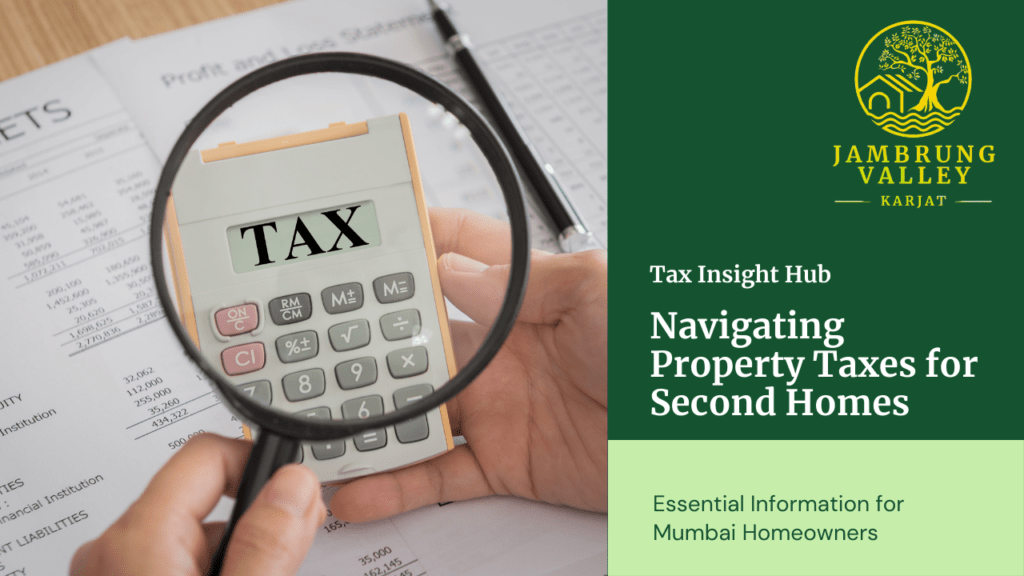
Understanding Property Taxes for Second Homes Near Mumbai
Investing in a second home near Mumbai is a significant financial decision, and understanding property taxes is crucial to avoid unexpected costs. Property taxes vary based on location, property size, and applicable municipal regulations. This guide provides a detailed breakdown of property taxes for second homes near Mumbai, covering tax calculations, exemptions, legal considerations, and ways to optimize tax payments.
What is Property Tax and How is it Calculated?
Property tax is a mandatory annual payment imposed by municipal corporations on real estate owners. It is calculated based on several factors, including:
- Property Type: Residential, commercial, or vacant land
- Location: Properties within city limits may have higher taxes than suburban areas
- Built-Up Area: The total constructed space of the property
- Age of Property: Older properties may have lower taxes compared to newly constructed homes
- Municipal Zone Classification: Different areas fall under different tax slabs
- Usage: Self-occupied or rented (though we focus only on ownership here)
Mumbai and its surrounding areas fall under different municipal jurisdictions, including the Brihanmumbai Municipal Corporation (BMC), Panvel Municipal Corporation, Karjat Municipal Council, and other local bodies.
Property Tax Rates for Second Homes Near Mumbai
1. Mumbai Metropolitan Region (MMR)
Properties within Mumbai city limits (BMC jurisdiction) are taxed based on the Capital Value System (CVS), which considers the market value of the property. The tax rate generally varies between 0.316% and 2.296% of the capital value, depending on the property’s use and size.
2. Navi Mumbai (NMMC Jurisdiction)
For properties under the Navi Mumbai Municipal Corporation (NMMC), taxes are levied based on property type and location. Residential properties have a lower tax rate than commercial properties. A general range is 0.2% to 1.5% of the capital value.
3. Karjat and Outskirts (Karjat Municipal Council & Gram Panchayat)
- Properties in Karjat and nearby areas such as Jambrung Valley often fall under Gram Panchayat taxation, which is significantly lower than municipal property taxes.
- Gram Panchayats typically impose a nominal property tax, making them a cost-effective choice for second home buyers.
- Villa projects in Karjat attract fewer municipal levies, making them an attractive investment.
Tax Benefits & Exemptions for Second Home Owners
Owning a second home comes with certain tax benefits, particularly if financed through a loan.
1. Tax Deduction on Home Loan Interest (Section 24(b))
- If the second home is purchased through a home loan, owners can claim deductions on the interest paid, up to ₹2 lakh per year.
- If the home remains vacant, the entire interest paid can be deducted without an upper limit.
2. Municipal Tax Deductions (Section 80C)
- Property tax paid to local bodies can be claimed as a deduction under Section 80C, reducing taxable income.
3. Wealth Tax Exemption
- Under current laws, individuals can own one self-occupied house without wealth tax liability. However, additional properties are considered under wealth tax, but exemptions exist if the second home is used for specific purposes.
Legal Aspects of Property Tax for Second Homes Near Mumbai
Before investing in a second home, it is crucial to check legal obligations related to property taxation:
1. RERA Compliance
- Always verify whether the property is RERA-registered to ensure transparency in tax calculations.
- Developers must provide detailed tax structures for newly built second homes.
2. Property Title & Encumbrance Certificate
- Ensure the property title is clear and does not have any pending property tax dues from previous owners.
3. Mutation and Property Tax Transfer
- Once the property is purchased, register it under your name with the local municipal authority to ensure tax payments are correctly recorded.
How to Pay Property Tax for Second Homes?
Paying property tax for second homes near Mumbai is a simple process:
- Online Payment Portals
- Most municipal corporations offer online payment portals, such as BMC, NMMC, KDMC, and Gram Panchayat websites.
- Physical Payment
- Payments can be made via designated banks or municipal offices.
- Challan-Based Payment
- Some rural areas still require physical challan payments at Gram Panchayat offices.
How to Reduce Property Tax Liability on Second Homes?
While property tax is unavoidable, there are ways to optimize tax payments:
1. Choosing the Right Location
- Investing in areas like Karjat and Jambrung Valley helps minimize property tax expenses while enjoying high appreciation potential.
2. Claiming Deductions
- Utilizing home loan benefits under Section 24(b) and municipal tax rebates can significantly reduce tax liability.
3. Keeping Property Records Updated
- Regularly update property details with the municipal corporation to avoid penalties due to incorrect tax calculations.
4. Checking for Tax Rebates
- Senior citizens, war veterans, and physically challenged individuals may qualify for tax exemptions.
Understanding property taxes for second homes near Mumbai is essential for making a financially sound investment. By knowing the applicable tax rates, legal considerations, and potential deductions, buyers can ensure smooth ownership without unexpected tax burdens. For those considering a villa investment in Karjat, properties in Gram Panchayat areas provide lower tax liabilities and excellent long-term value. Jambrung Valley, in particular, offers a unique blend of affordability, scenic beauty, and investment potential, making it a top choice for second home buyers.



